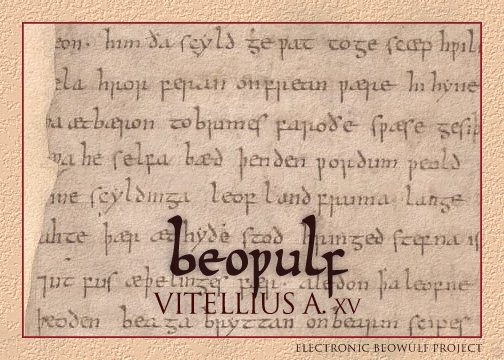

In the British Library there is a manuscript, its edges scorched and brittle, of Beowulf, one of the very earliest poems in English and its first great literary masterpiece. It exists only in this one vellum codex and has survived for a thousand years, telling of an even earlier time, when the heroic age still was remembered by a Christian audience.
The origin of the manuscript is completely unknown, but it may have belonged to one of the monasteries dissolved by Henry VIII. It first is mentioned in 1563 (the owner, who was gathering manuscripts for a proposed dictionary, signed his name on the first page) and eventually came into the possession of the antiquarian Sir Robert Cotton. His library, which was augmented by his son and grandson after his death in 1631, was the richest collection of Anglo-Saxon literary and historical documents in existence. The manuscripts were bound in leather and placed in fourteen bookcases, each watched over by the bust of one of the twelve Caesars, with those of Cleopatra and Faustina presiding over the remaining two. The manuscript of Beowulf was known by the designation Vitellius A. xv: the fifteenth volume on the first shelf under the bust of Vitellius.
In 1700, the Cottonian library was willed to the British nation and eventually moved to Ashburnham House at Westminster, which was thought to be a safer location. But, two years later, on October 23, 1731, there was a fire. The trustees broke into the burning building and carried away, or threw from the windows, hundreds of threatened volumes. Of the 958 manuscripts in the library, several hundred were severely damaged either by fire or water and thirteen completely destroyed, including a unique copy of The Battle of Maldon and Asser's Life of Alfred. Tightly bound between its leather covers, the Beowulf manuscript survived but was burnt along its exposed edges. (Interestingly, it was not cataloged at the time as being damaged.)
The collection was moved to the British Museum in 1753, when it was founded. But the manuscript remained in its original binding, and nothing was done to stop the dry, brittle pages from disintegrating. Over time, the margins and even some of the text, itself, gradually crumbled away, to be lost forever.
In 1786, some fifty years after the disastrous fire, G. J. Thorkelin, an Icelandic scholar, came to the Museum, looking for documents relating to Denmark, where the first part of Beowulf takes place. He made two complete copies of the manuscript, the first time this had been done, one by a professional copyist and the other, himself, and returned to Copenhagen to study them.
But then calamity. Denmark was occupied during the Napoleonic Wars and, in 1807, the English bombarded Copenhagen. Thorkelin's house burned and his manuscript for an edition of Beowulf, which just had been completed, was destroyed. The two transcripts were saved, however, and Thorkelin began his work over again, publishing the first printed edition of Beowulf in 1815.
The first English edition of Beowulf appeared in 1833, and, in its preparation, the manuscript was re-examined. It was discovered that the neglected volume had deteriorated even more and that many of the words Thorkelin had been able to decipher after the fire now were lost. Finally, in 1845, the British Museum took steps to preserve what remained. Each leaf was mounted on a paper frame and the manuscript rebound. Although this preserved the fragile edges, the paper and tape obscured some of the letters. Beginning in 1993, the manuscript has been re-examined and digitized as part of the Electronic Beowulf project.
Almost two thousand letters have disappeared along the brittle edges. Were it not for Thorkelin's transcripts, which are in the Royal Library of Denmark, many of these lost words and letters could not have been restored. There are only three other major manuscript collections of Old English poetry that survive. One can imagine the thousands of pages that did not: the heroic epics, the chronicles, the religious and devotional works, the songs and tales of the Anglo-Saxon scop.
All lost.
Reference: "'Their Present Miserable State of Cremation': the Restoration of the Cotton Library" by Andrew Prescott, in Sir Robert Cotton as Collector: Essays on an Early Stuart Courtier and His Legacy (1997) edited by C. J. Wright.